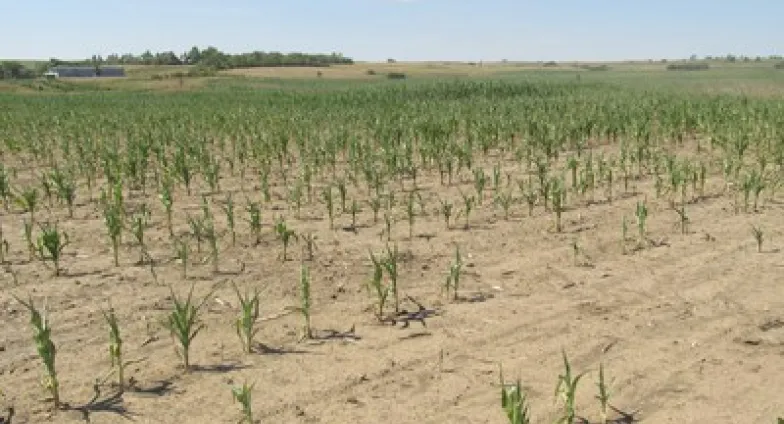Weed Control Strategies with Dry Conditions
Drought in Mercer County, 2017. Photo by NDSU
Dry conditions complicate weed control.
July 2017
Richard Zollinger, Weed Specialist
Choosing a herbicide is always difficult, but it is even more difficult with dry conditions. Dry conditions influence herbicide activity as well as the weed problems encountered.
Drought tolerant weeds such as kochia, Russian thistle, and perennial weeds are more troublesome with dry conditions than weeds such as wild mustard, wild buckwheat, or wild oats, which tend to be more serious problems with good growing conditions. Weed emergence also may be delayed or erratic in dry years. Weeds that normally would emerge early in the season and be controlled prior to planting may not emerge until later. Therefore, multiple flushes of weeds may occur as rainfall is received throughout the season.
Poor weed control from soil-applied herbicides often is attributed to dry conditions. Dry soil conditions actually are better than wet conditions for application and incorporation of volatile herbicides. Volatile herbicides do not vaporize as quickly from a dry soil surface as from a wet surface, so there is less herbicide loss. Herbicide incorporation and distribution also is more uniform in dry soils than wet soils. However, poor weed control with soil-applied herbicides often occurs with dry conditions because moisture is needed for herbicide activation and uptake by emerging weed seedlings.
Precipitation generally is required following a preemergence herbicide treatment to move the herbicide into the soil and make it available for absorption by the emerging weeds. Incorporated herbicides do not need moisture to move them into the soil, so they are less dependent on rainfall than preemergence herbicides for activation. However, even an incorporated herbicide requires moist soil for herbicide uptake by the weed seedlings, and some rain may be needed to allow an incorporated herbicide to give weed control.
Fall-applied herbicides generally will provide better weed control than spring-applied treatments in dry years. Fall-applied herbicides become more evenly distributed in the soil over winter and the herbicides should be activated by late fall rain, snow melt, or early spring rain. However, most fall-applied herbicides require incorporation in the fall to obtain good weed control. Fall tillage can bury plant residue and leave the field more vulnerable to soil erosion.
Preplant incorporated spring treatments often require tillage operations in excess of normal seedbed preparation for uniform incorporation. This requires extra time, which delays seeding and may cause loss of soil moisture.
Postemergence herbicides may be a viable alternative to soil-applied herbicides, especially with dry weather. Postemergence herbicides also are less effective with dry conditions than with good growing conditions, but the weed situation can be evaluated before making a decision about postemergence herbicide use. If a crop failure occurs or weed problems do not develop, a herbicide would not be needed. In addition, specific weed problems can be identified and the best herbicide for that situation selected.
Postemergence treatments have some disadvantages compared to preemergence treatments. Postemergence herbicides cannot always be applied at the proper time due to adverse environmental conditions. In addition, uneven crop stands and multiple weed flushes, which often occur with dry conditions, may complicate application timing.
Spray additives may improve weed control with postemergence herbicides during hot, dry conditions. Weeds become more tolerant to postemergence treatments during dry weather because of decreased herbicide absorption. Spray additives can improve spray coverage and increase absorption of some herbicides. Whether a spray additive should be used depends on the herbicides, crop and weed growth stage and condition, and environmental conditions. The herbicide label should provide information on additive type, rate, and the conditions under which spray additives should be used. Improper use of spray additives can reduce weed control or increase crop injury.
Weeds can compete with the crop prior to postemergence control, whereas soil-applied herbicides can eliminate early season competition by controlling the weeds prior to or soon after emergence. Postemergence herbicides generally should be applied early in the recommended application window in order to reduce or eliminate early season competition. Early application also will improve weed coverage since small weeds are covered more easily than larger weeds.
Thorough spray coverage and good control of dense weed populations is difficult to achieve with postemergence treatments. The use of soil-applied herbicides plus postemergence herbicides may be needed to achieve adequate control of dense weed populations.
Dry conditions complicate a weed control problem. Many times no single "best solution" is available for the weed problems. Sometimes an effective postemergence or preemergence treatment may not be available. Always evaluate the alternatives before deciding which herbicide to use. The best herbicide choice is unique for each situation depending on the crop, weed problems, environmental conditions, treatment cost, and viable alternatives.

